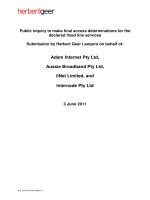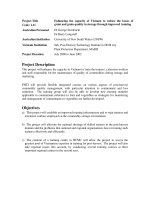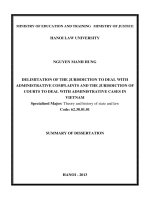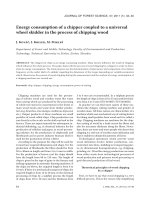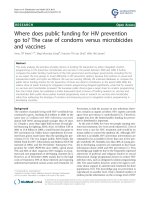FACTORS EFFECT TO FARM HOUSEHOLDS’ ACCESS TOFORMAL CREDIT THE CASE OF VIETNAM
Bạn đang xem bản rút gọn của tài liệu. Xem và tải ngay bản đầy đủ của tài liệu tại đây (335.2 KB, 8 trang )
Kỷ yếu công trình khoa học 2014 – Phần I
Trường Đại học Thăng Long 86
FACTORS EFFECT TO FARM HOUSEHOLDS’ ACCESS TO
FORMAL CREDIT: THE CASE OF VIETNAM
MA. Trinh Thi Thu Hang
MA. Ngo Khanh Huyen
Abstract: In certain stage of agricultural development, rural credit plays as a strong
force for futher development. When people use their owned elements to make production, they
realize that to make it more efficient, they need use of credit. That is said to be a key factor to
elimate the block on the way to development. Therefore, credit is considered as the most
flexible tool to excape from the difficult living condition. However, to meet lending conditions
from financial institutions is sometimes not easy.
Keywords: farm household, credit, Vietnam, probit.
1. Problem statement
Vietnam is a traditionally agricultural country with more than 70% of the population
living in rural areas. Most of them are poor and lack of capital. That is the most difficult thing
to escape from poverty. Therefore, the government has acknowledged that development in
rural and improvement in households’ living standard is strategic mission.
In the strategy of economic development of Vietnam, agriculture is considered as a
basic factor for the whole economic development. Especially, since Vietnam implemented the
open policy, the commerce of agriculture has made contribution to a large number of foreign
currency collection, increasing rural income and improvement in living conditions in rural
areas. Based on the importance of agriculture, the Government has pointed: “To create
significant change in agricultural production and rural economic sector and improve the high
living standard in rural areas. In coming years, agriculture and farmers and rural areas are
strategic issues and especially important. Therefore, these must be considered to promote
industrialization and modernization in agriculture and rural areas toward building diversified
agricultural products with high quality and competitiveness; then create conditions for
forming clean agriculture to increase added value in agriculture and forestry and aquaculture
from 3 to 3.2% per year. The growth rate of industry and services in agriculture must not be
lower than the national average rate”.
So credit is considered as a supportive tool for rural economic development in general
and households’ economic activities in particular. Therefore, it is necessary to develop a
financial market for the rural areas, in which credit activities must be a key indicator element
to attract capital for agriculture and rural development.
Although rural credit markets have developed for a long time, farm households’ access
to credit is still relatively limited. Over the past few years, the State bank of Vietnam has
initially eyed on the credit development and set up the rural credit policies. Despite a number
of recent policy changes designed to improve their access to credit, small household farms
and the rural sector in general, are recognized as facing servere credit restrictions.
Vietnam is in the process of implementing reforms of the banking system and
undertaking a gradual liberalization of credit markets (World Bank, 2003). However, small
Kỷ yếu công trình khoa học 2014 – Phần I
Trường Đại học Thăng Long 87
household farms in Vietnam and the rural sector in general, are recognized as facing credit
constraints (Wolz, 1997: World Bank, 1998; Duong and Izumida, 2002). Historically, the
credit market in Vietnam has been seriously distorted by government intervention including
priority credit given to State Owned Enterprises (SOEs) and various commodity production
programs (World Bank, 1998). Additionally, agricultural credit policy in Vietnam is often
used as an instrument of social welfare policy, targeting finance to poorer regions and
households, through the activities of the Vietnam Bank for the Poor (now, it is called Bank of
Social Policy).
In 1993, commercial loan availability for farm households commenced. Decree No
14/CP (1993) enabled farm households’ access to credit, whereas previously loans had only
been available to households through the institutions. Following this reform, credit could be
provided direct to households by commercial banks and financial organizations. But in fact,
few farming households can get loans easily from financial institutions due to credit proxy.
Some households can borrow as they wish while others may be denied access to formal credit.
Hence, the objectives of this paper are to review credit access at the farm household
level. The research is to examine which elements determine access to formal credit of farming
households in Vietnam. The data are collected from the Vietnam living household standard
surveys which was conducted in 2006 and 2008. The survey data are disaggregated by region,
loans source and socio- economic group, in order to investigate the effects of current credit
policy, to identify problems, and to suggest policy.
2. Agricultural credit in Vietnam
The banking sector in Vietnam was one of the first areas of the economy to be
deregulated and opened up to the private sector. Changes were made to the structure,
regulations and operations of the Vietnamese banking sector from late 1980s (World Bank,
2003), such that Wolz (1997, p5) comments that, “In 1997 the institutional set-up looks quite
heterogeneous”. Despite these changes, the Government of Vietnam has controlled credit
availability and interest rates in all sectors of the financial market through the activities and
regulation of the State Bank and through regulations controlling subject access to credit
(Wolz, 1997; Duong and Izumida, 2002; World Bank, 2003).
Agricultural credit providers
In Vietnam, the financial system for rural areas has three main segments. It can be
classified as follows:
-The formal credit sector
This is an official region consisting of the Bank of Agriculture and Rural
Development, the Bank for the Poor, people's credit funds subject to the supervision of banks,
and joint-stock banks. Formal credit institutions have increasingly expanded including Bank
of Agriculture and Rural Development, Bank of Social Policy, People’s credit funds,
international financial institutions such as World Bank, ADB, IMF, Non Government
Organizations. Of which, the Vietnamese Bank for Agriculture and Rural Development is the
major commercial source of formal credit for rural households.
- Semi-formal credit sector
Kỷ yếu công trình khoa học 2014 – Phần I
Trường Đại học Thăng Long 88
The semi-formal credit sector provides loans through socio-political unions in rural
areas and the level of activity if this sector in a region is related to priority programs of the
government, consignment services of the bank and the activity of unions.
- Informal credit sources
* Mutual lending among friends and neighbors.
* Rotating savings and credit associations promoting periodic savings which rotated as
a fund among a limited group of people who trust each other (generally from the same
hamlet)
* Specialized money lenders including pawnbrokers
* Traders giving advances in cash or in kind (for the rights to buy the harvest).
3. Methodology
The major dataset used for the purpose of this paper comes from VHLSS 2006 -2008,
VBARD, SBV, VLSS 2006 and 2008, collected a rich data set covering 64 provinces with
9,181 observations. Besides, we use published data from GSO and other various sources to
enrich descriptive analysis of farm households, focusing on access to credits from the formal
institutions.
Data source
The data used in the paper were obtained from a survey of 9,189 rural households in
64 provinces along Vietnam, which is conducted in 2006/2008 by VLSS to satisfactorily
analyse the determinants of access to formal credit.
Sampling frame
All households in 64 provinces/ cities in the country.
Sampling technique
Sample conludes 9,189 households in 64 provinces/cities, representing 8 economic
regions over country were selected to complete survey.
Table1. Scale of the surveyed sample by region
Regions
Households
Red River Delta
1,945
Northeast
1,317
Northwest
429
North Central
1,014
SouthCentralCoast
852
Kỷ yếu công trình khoa học 2014 – Phần I
Trường Đại học Thăng Long 89
Central Highlands
582
Southeast
1,188
Mekong Delta
1,863
Total
9,189
Source: Consolidation based on VLSS data 2006-2008
Methodology
The paper uses both descriptive and regression methods. A three-step analysis will be
used. In the first step, the descriptive method will be used to point out the determinants access
to formal credit of farm households. In the next step, the probit model will be used to
investigate effects of each determinant on probability of borrowing. In the last step, the paper
is aimed at exploring the effects of the determinants on probability of credit uptake. The
probit model will be used to reach to the objective. By using the three-step analysis, the paper
will provide more details for each factor influencing in obtaining loans of farm household
from the formal credit poviders.
Variables
The dependent variable for the probit analysis is of dichotomous nature representing
small holder farmer’s access to formal credit. This is the distinguish between those users or
non-users of formal credit in the study area. Y- household use credit from formal source
during the year. Y measures whether households have access to formal credit which takes the
value of 1 if the household take credit, 0 otherwise. The paper also uses a dummy variable as
a dependent variable in order to analyse how determinants affect probability of taking up
credit of farm household.
The Probit Model
The paper aims at investigating effects of the determinants on farm household’s access
to formal credit. The Probit model will be used to reach to the objective.
Prob(Y=1|X, F, S =
)( uSFX
s
In which,
Φ is probibality density function of the standard normal. Y is measured the result of
the credit access of the farm household. Y can be equal 1 or 0. Y = 1 if farm households
receive formal credit, and Y = 0 if farm households do not receive formal credit. X, F, S refers
to the factors which have impacts on whether the formal credit can be approved or not. X
typically includes farm household head variable (such as gender, age, and education),
households’ characteristic variable and development of financial market variable. u is error
terms.
After estimating the parameters β, γ, φ, the marginal effects should be calculated to
measure the effect of changes in independent variables or determinants on uptake of credit.
Kỷ yếu công trình khoa học 2014 – Phần I
Trường Đại học Thăng Long 90
The effects of determinants on probability are calculated via marginal effects.
Z
uSFX
Z
ZYob
effectinalmThe
)(
)1(Pr
arg
In whichZ = (X, F, S) and
),,,(
4. The result
Effect on probability of a household with accessing rural formal credit.
Table2
Variables
dy/dx
Household head
Gender*
.0235332
Age*
.1419315
Education*
2157835
Marital status*
.0925638
Ethnic group*
0878688
Region
.010569
Household characteristics
Household size*
.0734787
Poor*
.23006
Health*
.0289401
Healthhexpenditure*
062438
Income*
.2006752
Purpose of loan*
0163484
Fix assets*
.0270451
Development of local financial market
Number of banks*
0526784
Kỷ yếu công trình khoa học 2014 – Phần I
Trường Đại học Thăng Long 91
Source of loan*
.0190423
Source: Consolidation based on VLSS data 2006-2008
Obtaining loan from the formal credit providers is the target of every households in
meeting demand for credit usage. The study tries to explore which determinant have most
influence the probability of farm households getting loan.
Age
Influence in access to formal credit by rural household. Regression results show that
age above 50 people have difficulty to take credit.
Education
Regression results show that household who has university degree or more higher
educational level, can receive a loan from banks. Because they are found to earn money with
high paid.
Ethnic group
The rate of Kinh people getting loan is higher than that of other ethnic group. It can be
explained that Kinh access to loan for consuming or repayment purpose.
Region
The outcome of loan users are different by regions. Based on tables 4.3, the proportion
of rural household has loan users in both Mekong Data and Red River Data higher than in
other regions, that in line with initial expection. It was 22.07% and 16.8% respectively.
Household
The household with more than four members get fairly higher probability of taking up
credit.
Poor or non poor has significant association with the probability of whether a
household receives a formal loan. It comes to no surprise that the estimated result presents
that the probability of loan used by the non-poor group is higher that used by the poor ones.
Health are associated with the expectation. It has a significant effect on the probability
of meeting uptake of loan. The positive signs of this dumming variable in whether a person
get a loan is how his/her health satisfy labouring ability.
Heath expenditure has also negative relations with the probality of accessing to formal
credit by the farm household. The result is beyond the initial expectation. It can be explained
that there is a proportition of household pay no or less cost for health treatment; they save
money more. They have lower demand for credit, particularly in health treatment.
Income has significant positive relation with the probability of access to credit. The
positive signs on income indicate that the household who are high paid have a higher
probability of borrowing than other.
Kỷ yếu công trình khoa học 2014 – Phần I
Trường Đại học Thăng Long 92
Number of banks the probability that household reach out a loan does not depend on
the number of bank distribution in the local areas.
Source of loans has positive association with the probability of reaching out loan.
5. Conclusion and recommendation
In recent years, Vietnam’s Government has focused on agricultural and rural
development. Household economic sector is considered as a part of private enterprises in the
process of social economic development in rural Vietnam. The reality points out that, capital
is important factor to expand production.
Taking up loan is a significant to the farm household. It helps households to improve
living standard and expansion in prodiction. Additionally, it contributed to the poor
alleviation programm and completing the national targets by the Government. As regard to
the Government, some relevant studies in Vietnam also focus on analysing why a farm
household face with difficulties in getting formal credit from formal financial institutions.
To improve the probability of borrowing by farm household the Government should
focus on capital for agricultural and rural development and introduce preferential policy
encourage farmers to enrich by loans from banks.
Besides, Government should devesify its capital sources and introduce variety of
adequate of credit products in appliance with the capcity and educational level of farm
household and custome where they live. Therefore, they can ultilize the loan for purpose
ussage.
In some cases, the Government can establish the enterprises which buy the rural
product from the farmers esspecially for exported products. Therefore Government not only
can support agricultural production, but also he assure rural credit security by loan users as
well.
Currently, it is found that lending proceduces are still complicated. Based on lending
conditions from banks, few farm household can access to credit. Even if they get loan, they
just take a small amount which is not enough to carry out agricultural operations. Therefore, it
is necessary to losen thelend and create favourable conditions for rural household to access to
credit.
6. References
[1]. Floro, S.L., Yotopoulos, P.A. (1991). Informal credit markets and the new
institutional economics: The case of Philippine Agriculture Boulder: Westview Press.
[2]. Le, Huu Anh (2002). Land use in Vietnam: Impacts of tax and credit policies,
presented at the Vietnam Workshop. Land Use in Vietnam: Policy Issues and Research held at
The University of Sydney, November 14-15-2002.
[3]. Lensink, R., Nguyen, Van Ngan and Le, Khuong Ninh (2005). Determinants of
farming households’ access to formal credit in the Mekong Delta, Vietnam. Final report for
NPT-part B4- paper 9Maddala, G.S (2002). Introduction to Econometrics. John Wiley and
sons Lt, England. 3
rd
Edition.
Kỷ yếu công trình khoa học 2014 – Phần I
Trường Đại học Thăng Long 93
[4]. Marsh, S.P., MacAulay, T.G. (2003). Farm size and land use changes in Vietnam
following land reforms. Contributed paper presented at the 47
th
Annual Conference of the
Australian Agricultural and Resource Economics Society, Esplanade Hotel, Fremantle, 12-
14
th
February 2003.
[5]. Pham, Bao Duong and Izumida, Yoichi (2002). Rural Development Finance in
Vietnam: A Microeconomic Analysis of Household Surveys. World Development 30 (2),
pp.319-335.
[6]. Ray, D. (1998). Development Economics, New Jersey: PrincetonUniversity
Press.
[7]. Sally, P., Mash, T., MacAulay, T.G. and Le, Huu Anh (2004). Credit use in farm
households in Vietnam: Implications for rural credit policy. Contributed paper presented at
48
th
Annual conference of the Australian Agricultural and resource Economics Society, 11-13
Febuary, 2004, SheratonTowers, Melbourne.
[8]. Stiglitz, J.E., Hoff, K. (1993). ‘Imperfect information and rural credit markets:
Puzzles and policy perspective’ in Hoff, K., Braverman, A. and Stiglitz, J.E. (1993) The
economics of rural organization: Theory, Practice and Policy Oxford: Oxford University
Press, pp33-52.
[9]. Tran, Binh Minh (2007). Determinants of credit rationing in rural credit market-
an analysis from the VHLSS 02, Vietnam-Netherlands project for Master degree in
development economics, Hanoi.
[10]. Wolz, A. (1997). The Transformation of Rural Finance Systems in Vietnam,
Diskussionsschriften der Foreschungsstelle fur International Wirtchafts- und
Agrarentwichklung eV (FIA), No. 60, Heideberg.
[11]. World Bank (1998). Advancing Rural Development in Vietnam: A Vision and
Strategy for Action, The World Bank, Washington, DC.
[12]. World Bank (2003). Vietnam: Delivering on its Promise. Development Report
2003, the World Bank in collaboration with the ADB Vietnam Consultative Group Meeting,
Hanoi, 10-11, December 2002.

